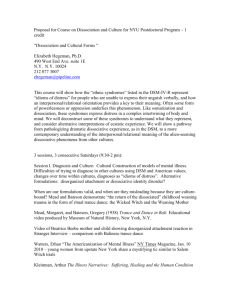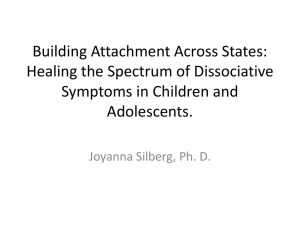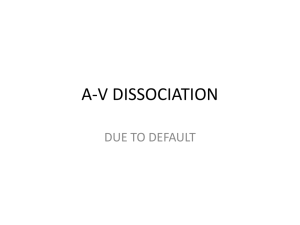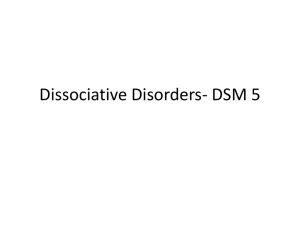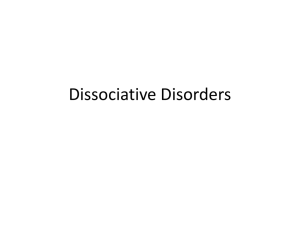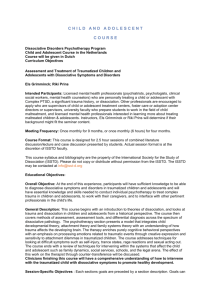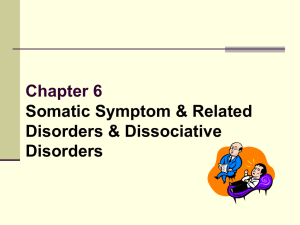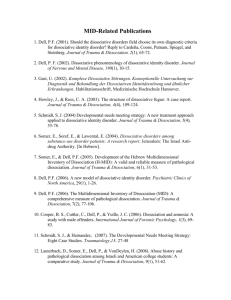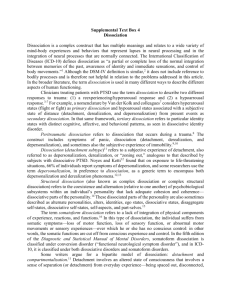Clinical & Theoretical Issues in the Treatment of Pathological
advertisement
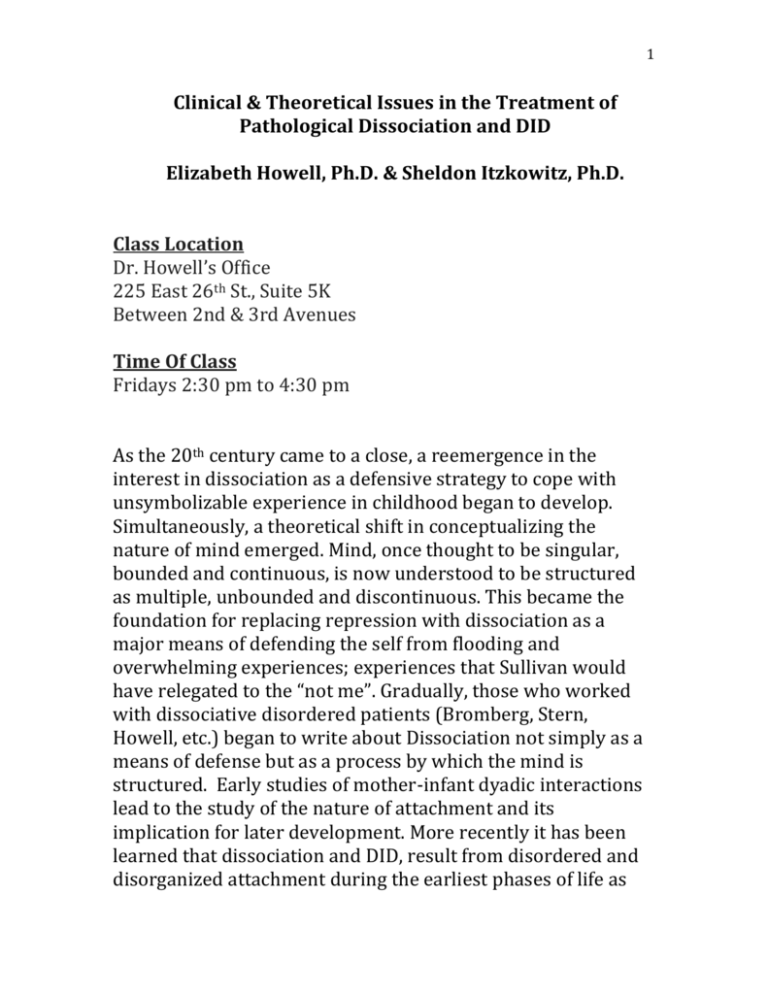
1 Clinical & Theoretical Issues in the Treatment of Pathological Dissociation and DID Elizabeth Howell, Ph.D. & Sheldon Itzkowitz, Ph.D. Class Location Dr. Howell’s Office 225 East 26th St., Suite 5K Between 2nd & 3rd Avenues Time Of Class Fridays 2:30 pm to 4:30 pm As the 20th century came to a close, a reemergence in the interest in dissociation as a defensive strategy to cope with unsymbolizable experience in childhood began to develop. Simultaneously, a theoretical shift in conceptualizing the nature of mind emerged. Mind, once thought to be singular, bounded and continuous, is now understood to be structured as multiple, unbounded and discontinuous. This became the foundation for replacing repression with dissociation as a major means of defending the self from flooding and overwhelming experiences; experiences that Sullivan would have relegated to the “not me”. Gradually, those who worked with dissociative disordered patients (Bromberg, Stern, Howell, etc.) began to write about Dissociation not simply as a means of defense but as a process by which the mind is structured. Early studies of mother-infant dyadic interactions lead to the study of the nature of attachment and its implication for later development. More recently it has been learned that dissociation and DID, result from disordered and disorganized attachment during the earliest phases of life as 2 well as from overwhelming traumatic experiences of childhood. This course is designed as a clinical, experiential and theoretical venture to explore how the traumas of real life, not merely fantasized experience in early childhood, structure the mind dissociatively so that aspects of the child’s understanding of the external world, internal experience and feelings become unavailable to conscious attention, segmented, and/or unformulated. Dissociative Identity Disorder (DID), a complex defensive method of coping with overwhelming interpersonal trauma is not so different in kind from more “normal” dissociative segmentation of experience. Yet, DID involves the development of different segments of experiencing that have their own sense of separate identity—their own sense of an “I”—including a sense of personal autobiographical memory; and they may have different names. This division of the self into different dissociated subjectivities puts people with DID at a loss as to how to understand or explain their experience and it often makes their lives very difficult to manage. Recent studies (e.g., Brand, Classen, Lanius, et al., 2009) have shown that the prevalence rates of dissociative disorders in outpatients range from 12-38% of the population. Despite the frequent denial of the existence of DID, current epidemiological research sets the prevalence of DID at 1.1% to 3% of the general population (ISST-D Guidelines, in press). However, because of the paucity of training, clinicians are often at a loss as to how to recognize, diagnose, and work with their highly dissociative patients. All too frequently, when clinicians do recognize that their patient has a serious dissociative disorder, they fear that they will be unable to acquire the skills necessary to treat dissociation and that they must refer their 3 patient out. A therapeutic relationship may thus be unnecessarily broken. Candidates will learn about the early pre-analytic work done on dissociation and the contributions to understanding the “Dissociative Mind” from the Interpersonal and relational models. Modern thinkers such as, Bromberg, Howell, Stern, and Chefetz will be studied. Analytic case material in the form of video clips from Dr. Itzkowitz’s clinical practice, as well as case material from candidate’s practices, will be used to highlight and demonstrate many of the concepts underlying the treatment of DID. An exploration of neuroscience and cognitive contributions to dissociation, along with contributions from attachment theory will further inform the candidates understanding of theory and practice. Finally, candidates will learn, how to handle difficult clinical situations that inevitably arise in the work with DID patients. Treatment of Traumatic Dissociation and Dissociative Identity Disorder: Clinical & Theoretical Issues 4 Elizabeth Howell, Ph.D. & Sheldon Itzkowitz, Ph.D. Syllabus Week 1. Dissociation: A Model of the Psyche Brief Video Presentation-Itzkowitz Readings: 1. Bromberg, P.M. (2001a), The Gorilla Did It: Some Thoughts on Dissociation, the Real and the Really Real. Psychoanalytic Dialogues, 11:385–404. 2. Howell, E. (2005) The Dissociative Mind. Hillsdale, NJ: The Analytic Press. a) Introduction: pp. 1-11. b) Chap. 1, Dissociation: A Model of the Psyche, pp. 14-37 3. ___________(2011), Understanding and Treating Dissociative Identity Disorder. NY Taylor & Francis a) Introduction: pp. 3-8. b) Chapter 2: The Dynamic Unconscious and the Dissociative Structure of the Mind, pp. 27-38, sections on Relationality and Multiplicity, Dissociative multiplicity, and The construct of the unconscious. 4. Stern, D. (2010) Partners In Thought. NY: Taylor & Francis Chapter1 Week 2. Early History of DID 5 Brief Video Presentation-Itzkowitz Readings: 1. Ferenczi, S. (1931). Child Analysis in the Analysis of Adults. 2. Ferenczi, S. (1932/1949). Confusion of Tongues Between the Adult and the Child. International Journal of Psycho-Analysis, 30, 225–231. 3. Howell, E. (2011) Understanding and Treating Dissociative Identity Disorder. NY: Taylor & Francis. Chapter 2: The Dynamic Unconscious and the Dissociative Structure of the Mind, pp. 38-54, “DID as the Cheshire Cat: Now you see it, now you don’t: The Social and Historical Context that Shaped our Understanding of DID.” Week 3. Interpersonal Contributions And Relational Traditions Brief Video Presentation-Itzkowitz Readings: 1. Sullivan, H. S. 1964 The illusion of personal individuality. In: The Fusion of Psychiatry and Social Science. New York: W. W. Norton and Company, Inc. 2. Howell, E. (2005) The Dissociative Mind. Hillsdale, NJ: The Analytic Press. Chapter 4:Interpersonal Contributions and Relational Traditions: Sullivan, Bromberg, Davies and FrawleyO’Dea and Stern. Howell, E. (2005). Chapter 4, pp. 92-120. 6 3. Hirsch, I. (1994) Dissociation and the Interpersonal. Self Contemporary Psychoanalysis 30: 777-799 4. Hirsch, I. (1997) The Widening of the Concept of Dissociation. Journal of American Academy of Psychoanalysis, 25:603-615 Week 4. Dissociated Self-States, Trauma, and Disorganized Attachment Brief Video Presentation-Itzkowitz Readings: 1. Bromberg, P. (2008) Shrinking the Tsunami: Affect Regulation, Dissociation And the Shadow of the Flood. Contemporary Psychoanalysis, 44: 329-350 2. Lyons-Ruth, (2001). The two-person construction of defenses: Disorganized Attachment Strategies, Unintegrated Mental States, and Hostile/Helpless Relational Processes. Psychologist Psychoanalyst, 21(1), 40–45. Week. 5. Dreams In DID Brief Video Presentation Readings: 1. Barrett, D. L. (1994), The Dream Character As A Prototype For the Multiple Personality “Alter.” In: Dissociation, ed. S. J. Lynn & J. Rhue. Washington, DC: American Psychological Association Press, pp. 123–135. 7 2. Barret, D.L. (1996), Dreams in Multiple Personality Disorder. In: Trauma andDreams, ed. D. Barrett. Cambridge, MA: Harvard University Press, pp.68–81. 3.Howell, E. (2011). Understanding and Treating DID, Ch. 13: Dreams in DID Week 6. Specific Issues In Treatment Video Presentation-Itzkowitz Readings: 1. Bromberg, P. (2001) Treating Patients with Symptoms and Symptoms with Patience: Reflections on Shame, Dissociation, and Eating Disorders. (11) 891-912. 2. Howell, E. F. (2002). Back to the 'States': Victim and Abuser States in Borderline Personality Disorder," Psychoanalytic Dialogues, 12:6, 921-957. Week 7. Neurobiological Correlates of Dissociated SelfStates Readings: 1. Howell, E. (2011) Some Neurobiological Correlates of the Structure and Psychodynamics of Dissociated Self-States in: Understanding and Treating Dissociative Identity Disorder NY: Taylor & Francis pg. 109 – 131
